
Got lots of apples?

Make some juice!
If you are lucky enough to have bowlfuls (or large basketfuls like I do) of fresh apples that need to be used, making juice is a great way to make the best of them. Freshly pressed apple juice is nothing like the sort that you pour out of a carton or bottle bought from a store, or at a farmer's market, even.
If you have a juicer at hand, it's a relatively easy job. If you don't, you can still make juice using a food processor or blender, by processing chopped and cored (and peeled, if you like) apples and filtering them with cheesecloth or something similar. The more tightly you press/squeeze the processed fruits, the thicker, sweeter and 'cloudier' juice you end up with. It's tasty.
But if you do have a juicer, you can have juice that is lighter and clearer in both taste and appearance.

And if you use your red apples unpeeled (or partially peeled like I'd often do, for I tend to use fruits with bruises that need to be removed before use), you'll have your juice in the prettiest shade of pink.
(Note that fresh apple juice, like fresh apples themselves, tends to turn brown quickly if left untreated; if you are not drinking it at once, add a pinch of ascorbic acid [vitamin C] as soon as you start pressing your apples. Otherwise, you'd want to can the juice for longer storage, though I've never tried it myself.)
Now depending on the type of the juicer you use, your apple juice is likely to have some frothy foam on the surface, not unlike so-called 'beer head'.

I supposed this was something undesirable that needs to be removed before consumption - the less foam the juice develops, the better. And the juicer I use here at my mother's produces very foamy juice. So I used to take the trouble to spoon it out as much as I could, with an intention to make my juice clearer and neater.
That was until one day when I somehow took a small mouthful of the foam as I was spooning it. To my surprise, it didn't taste bad - rather good, actually. Delicious, even. It was light and fluffy, sweet and faintly apple-y, with melt-in-your-mouth subtlety to it. Pleasantly shocked, I took more spoonfuls and even called over mother, who was both surprised and impressed at how good it tasted as she tried some.
From that time on, it has became my routine to skim off the foam whenever I press apple juice, as soon as the jug is full; there is no turning back. I can't believe I used to throw it all away - what a waste! Now I can hardly decide which I look forward to more: the juice itself or the foam sitting on top of it.
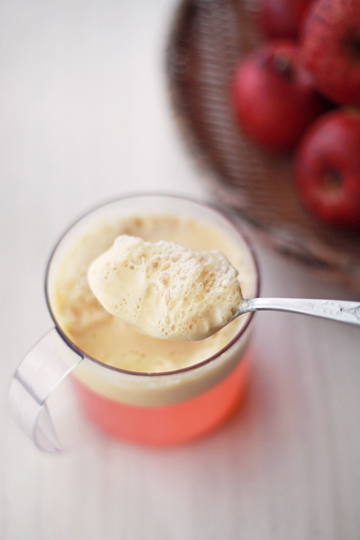
The thickest part of the foam is almost like mousse, delicate and ephemeral. If you could serve it in a small, pretty bowl, it would make a fine dessert. What makes it truly special, however, is that it can only be tasted immediately after the juice is pressed; the foam thins down very quickly as it sits, getting brown and bitter-tasting, and turning into a generally unpleasant thing to put into your mouth.
So this is a treat reserved for those who press their own apple juice, a reward for the labor of all the cutting and coring - unless you have someone to do the work for your as you wait and watch, a spoon ready in your hand. (And if you think I'm exaggerating, I hardly am; I've had someone try it and he even claimed it was one of the best things he had ever tasted.)
Now, there is something else I used to throw away when I made apple juice.
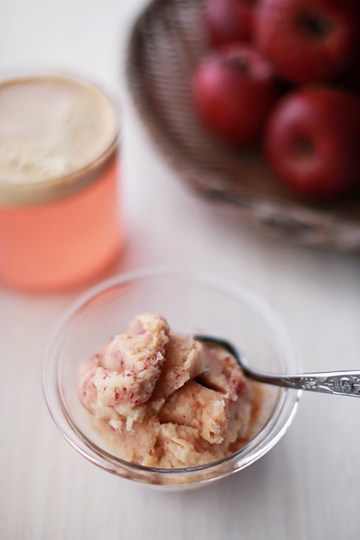
The pulp that remains after the apples have been pressed. I imagine this would also depend on the type of juicer, but ours produces a very clear juice - and leaves a lot of pulp behind, still fairly juicy. I suppose I could squeeze it down to extract more juice, but I never bothered, and threw the whole thing away, though a little hesitantly.
Then it occurred to me a week ago or so; I could maybe try and use some of it when baking bread?
For the past month or so I was baking bread every day (in the bread making machine, mind you), trying out different recipes found on the Internet and books. And I knew some people used the residual pulp after juicing carrots or apples to partly replace the liquid in their bread dough, so this wouldn't be such a mad idea, I suspected.
I started with this recipe (in Japanese) for bread using grated carrots (though not fruit juice residue). It seems to be a plain bread recipe, except that about 2/5 of the liquid content is grated fresh carrot and the juice (and oh, it's sweetened with honey, not sugar). I substituted the apple pulp for the grated carrots, and added a handful of sultanas towards the end of kneading.
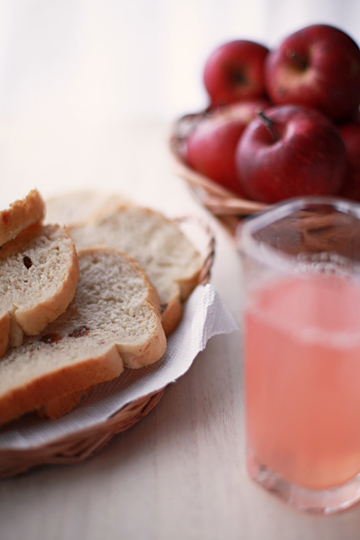
The bread came out alright - reasonably light and fluffy, except I didn't taste apple at all. I tried it twice more, increasing the amount of apple pulp - up to about 80-90% of the liquid content in my third batch. That way, the bread came out a bit dense, but not too heavy. But it still didn't taste of apple. It was just like a regular (though slightly dense) raisin loaf. (I've also used walnuts instead of raisins, in which case it was a regular walnut loaf.)
I had thought about using apple juice (freshly pressed, of course) in addition to the apple pulp, but then I realized it would be the same as using grated fresh apples. Besides, I had already tried and baked bread using grated fresh apples in place of water, and it had not tasted much of apples either.
So I have decided to accept that the apple juice pulp alone would not make an apple-y loaf of bread. That said, I have also deiced that this would be a good way to use the residual apple pulp, at least some of it; even though it does not make my bread taste of apples, it does not ruin the taste or texture of my bread either, so I can confidently use it as a part substitute to water in the dough. It makes a great alternative to tossing it all in the trash (or compost).
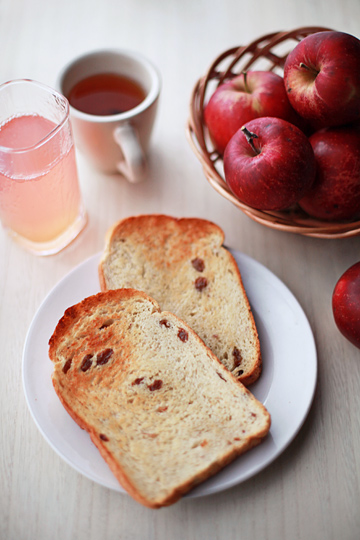
All in all, making apple juice at home is a great practice - it does involve a bit of work, but the reward is huge. Now that I know I can also enjoy the frothy 'mousse' and that I can 'recycle' some of the residual pulp, the satisfaction is almost threefold for me.
And to my mother's family, this above all means an easy way to use up some of the unsalable apples.

They have apple orchards here in the small town of Tateshina in Nagano Prefecture, at the very heart of one of the country's biggest and oldest apple-growing areas. The family has been growing and selling apples for half a century, although the business and production has shrunk as the apple-growing family members get old.
Commercially, the most important cultivar here is fuji, which comes at the end of the apple season, from mid November to early December. Before then, there are a whole string of other varieties coming up, starting in as early as mid August, but the decent ones usually start appearing towards the end of September.
And in mid October comes another one of my favorite cultivars - called kogyoku, a smaller, crimson-skinned, distinctly tart variety that smells particularly sweet.
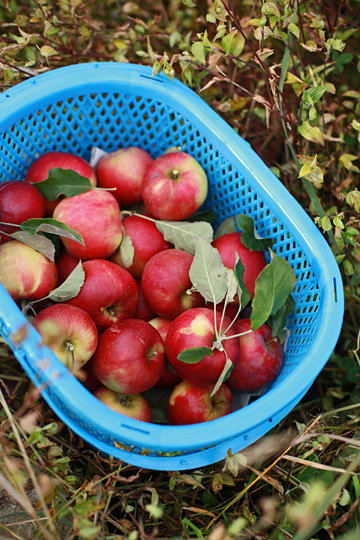
Kogyoku, or 'ruby', is (or close to) an old cultivar also known as Jonathan. Now nearly all apple varieties commercially grown in Japan are so-called sweet apples, as opposed to cooking varieties. Kogyoku is a sweet apple, yet being a very tart kind, it has been used primarily for baking. So much so, a lot of people today consider kogyoku as a baking apple and not necessarily desirable for eating, for which there are a plenty of other sweeter varieties around.
As the Japanese people are very partial to sweet fruits in general, less-sweet cultivars like kogyoku got taken over by newer, sweeter ones, and many have eventually disappeared from the market. Kogyoku very nearly followed the same fate, and at one point it was difficult to find them at stores.
It was only recently that kogyoku started to re-gain popularity, especially among professional and home bakers who seek better apples for baking, or perhaps jam-making. Now you can find kogyoku more and more, though very briefly; kogyoku, unlike fuji, is not suitable for long storage, for it loses its crispness and flavor very quickly.

And in fact, most kogyoku apples - or those of any other variety, for that matter - you find at stores in Tokyo and perhaps many other places are sadly way past their prime, in my humble opinion. But that's probably because I know how the really good apples taste when they are fresh and properly stored.
So apple growers pick their kogyoku quick and sell them away quick, and try to use up all the fruits left behind being deemed unsuitable for sale. Lots of them are made into juice, I assume, and kogyoku does make wonderful juice with its tartness and sweetness; other varieties, including fuji, tend to make the juice a little too sweet.

I, for one, like to make juice and bake with kogyoku a lot, and now that we have done with picking and shipping out this year's kogyoku apples, I am looking forward to doing a bit of baking myself.
In the meantime, growers are already back at working on their fuji apples and anxiously waiting for them to ripe and ready. With less than a month left before the harvest of fuji is supposed to start, everyone is crossing their fingers for the proper cold temperatures to arrive. This hasn't been a great year for apples and a lot of other fruits with an unusually cold spring followed by a record-hot summer, and it has only just started to cool down, which apples need to ripen to the fullest.
Soon enough, it will be the busiest time of year for them, and I know it will be so for me, too, as I try and help the family with some of their work.

So for now, I stay in a warm room and bake, juice, and try other good things with our leftover kogyoku before our life is taken over by fuji, and eventually, the end-of-year frenzy. Soon enough.

13 comments:
Lovely post, really enjoyed it.
We have just got an allotment and it has two apple trees on it - one a cooking apple and the other a Charles Russ, I think.
This year's fruit is all gone, the previous owner harvested it, quite rightly.
But next year we shall have lots and making our own juice sounds wonderful.
I just bought my first juicer this past Wednesday! I'm so excited to try apple juice, thanks for sharing the secret about the pulp! :)
Great post. I think if you replace the water with apple pulp in your bread it should be healthier, even if you cant taste the apple. I imagine it has more fiber in it at the very least.
I wonder what the foam is exactly. Maybe just the agitation of the juice makes some of it foamy? I also wonder what you might be able to make with it, I have seen some chefs on tv use foams in their dishes, but usually its on top of something else for extra flavor. Maybe apple foam on vanilla ice cream :)
Apple juice is great!
You can go about with pure apple without adding anything else but it would still taste great!
Ooooh. I also used to throw the foamy top. I'm going to try that next time. Lovely post!
Happy to see yummy pulpy apple juice.
I love apple in any form. Really it is a nice post.
Beautiful photographs, as usual! Your post made me quite nostalgic - I grew up drinking fresh apple juice - and also made me miss Nagano Prefecture so much. It's lovely there in the autumn.
hi there, thanks all for leaving a comment!
Melissa - i think the foam would be some form of concentrated flavor, but not sure. it browns and hardens so quick it'd be tricky to really "serve", but i might have a scoop of vanilla ice cream handy next time i juice apples! :)
oh how beautiful. haven't really come across pink apple juice before! it's really pretty! even when my apples are unpeeled, they still come out yellowy, i wonder why? thanks for sharing. maybe you can use the pulp to make muffins or cake too!
Lovely post and even lovelier photos. I love apple juices but like heavenlovefleur, they also come out yellow. I always discard the pulp but thanks for giving me the bread making idea.
thanks heavenwildfleur & Christmas Sweets - re: pink juice, i wonder if it's got something to do with the type of apples you use? the one i used (johnathan) has a REALLY red skin and tints everything pretty pink! I also used vitamin c to better preserve the color, too.
Can I say that this was a lovely story of an apple. I enjoyed the photographs also.
I myself bought my first juicer no more than 1 hour ago and promptly opened, cleaned, and plugged it in. I had bought some locally grown Michigan apples, small and wax-less. I juiced them 30 minutes ago, and sit here with a messy cup that was 5 minutes ago full to the brim.
I personally try everything before thinking, and the second I saw the foam I licked a bit and my mind was blown. I didn't even know that there WOULD be foam. And I am very happy I didn't skim it! I can't imagine throwing away half of a homemade food before at least trying it, and boy am I glad I did! Mmmm~
Post a Comment